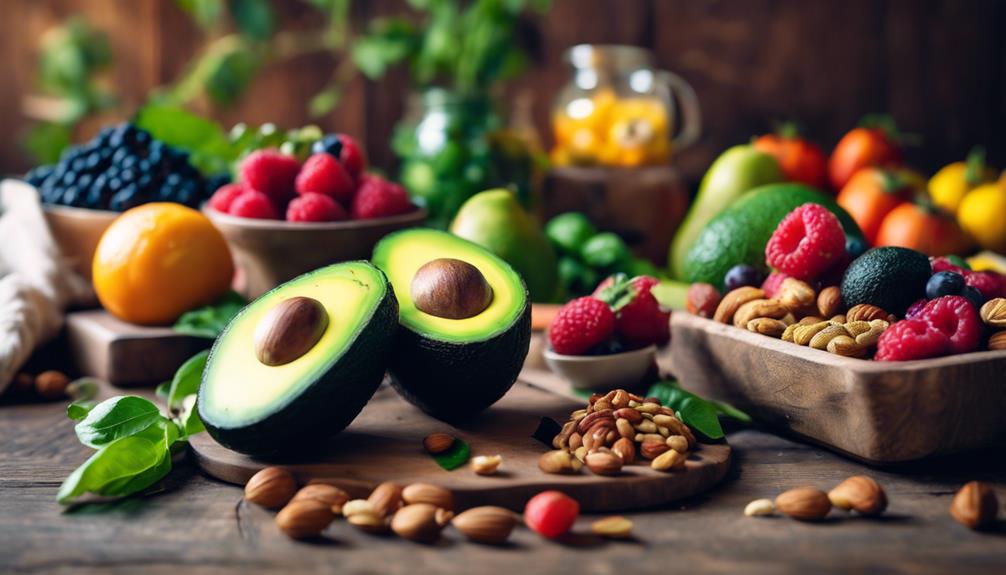For a healthy lifestyle, I focus on 15 nutrient-dense foods that truly nourish my body. These include fresh fruits, vegetables, whole grains, and lean proteins, which are packed with vitamins and minerals. Foods like avocados, nuts, and legumes provide healthy fats and fiber. Berries are rich in antioxidants, while fish offers omega-3 fatty acids. I also emphasize whole, minimally processed foods to avoid harmful additives. Choosing organic options can further enhance health benefits. By incorporating these foods into my diet, I can support overall wellness. Keep exploring for additional tips on how to optimize your nutrition.
Key Takeaways
- Fruits and Vegetables: Rich in vitamins, minerals, and antioxidants, they support overall health and reduce disease risk.
- Whole Grains: Foods like quinoa and brown rice provide fiber and essential nutrients, promoting digestive health and sustained energy levels.
- Lean Proteins: Sources such as chicken, fish, and legumes are crucial for muscle repair and metabolic function, aiding weight management.
- Healthy Fats: Incorporate avocados, nuts, and olive oil for heart health and improved nutrient absorption, balancing your overall diet.
Love Real Food: Vegetarian Cookbook

Whether you're a dedicated vegetarian, a curious omnivore, or someone seeking healthier meal options, Kathryne Taylor's *Love Real Food: Vegetarian Cookbook* delivers over 100 delicious, approachable recipes that nourish the body and delight the senses.
This cookbook features a variety of meatless recipes that aren't only healthy but also easy to prepare.
I've tried several recipes, like the Southwestern Roasted Veggie Salad and the Butternut Squash Chipotle Chili, and they've all turned out great.
Each recipe includes tips for ingredient substitutions, so I can adapt them based on what I've at home.
The high-quality photos guide me through the cooking process, making it easy to visualize the outcome.
Overall, it's a practical resource for anyone looking to eat better.
Best For: Those seeking healthy, delicious vegetarian recipes that are easy to prepare and suitable for various dietary needs.
Pros:
- Wide variety of recipes that cater to both vegetarians and those looking to incorporate more plant-based meals into their diet.
- User-friendly layout with high-quality photos and helpful tips for ingredient substitutions, making cooking accessible for all skill levels.
Cons:
- Limited focus on meat-based recipes, which may not appeal to strict omnivores or those who prefer meat-centric meals.
- Availability of some ingredients may be a challenge for those in remote areas or without access to specialty grocery stores.
Skinny Ms. Slow Cooker

If you're looking to enjoy healthy meals with minimal effort, Skinny Ms. Slow Cooker is perfect for busy individuals who want to maintain a nutritious lifestyle without relying on processed foods.
This cookbook features 155 slow cooker recipes that focus on natural ingredients, with helpful nutritional data for each dish. I appreciate the variety, from Vegetable Soup to Hamburger Pie, making it family-friendly and suitable for all cooking skill levels.
However, I've noticed that the portion sizes can be small, averaging about 1/2 cup, which may not satisfy everyone. The Kindle edition has some navigation issues, but overall, the healthy recipes encourage good eating habits.
Just be prepared to adjust portions if you're cooking for more than one or two people.
Best For: Individuals and families seeking healthy, convenient meals with the ease of slow cooking.
Pros:
- Variety of recipes: Offers a broad selection of healthy dishes, catering to different tastes and skill levels.
- Nutritional data: Provides detailed nutritional information for each recipe, promoting informed eating choices.
Cons:
- Small portion sizes: Average servings of 1/2 cup may not be sufficient for larger appetites, requiring adjustments.
- Navigation issues: The Kindle edition lacks direct links in the table of contents, complicating access to recipes.
Immune System Diet & Lifestyle Guide

For anyone looking to boost their immune system naturally, 'Immune System Diet & Lifestyle' offers practical dietary and lifestyle recommendations that are both accessible and effective.
The book emphasizes eating a diet rich in vitamins and minerals. I've learned the importance of including Vitamin C, Zinc, and Vitamin D in my meals. Freshly prepared, gluten-free foods like fish and meat are encouraged, while avoiding gluten can help too.
Alongside diet, the book stresses lifestyle changes. It suggests maximizing rest even with a busy schedule and using natural remedies for relaxation.
I appreciate the quick recipes that fit easily into my day. Overall, this guide empowers me to take charge of my health, focusing on prevention for a stronger immune system.
Best For: Individuals seeking to enhance their immune system through practical dietary and lifestyle changes without relying on expensive supplements.
Pros:
- Accessible and practical dietary recommendations that can easily be integrated into daily meals.
- Emphasis on prevention and empowerment, encouraging a proactive approach to health.
Cons:
- May not cater to vegans or vegetarians, limiting options for those following plant-based diets.
- Some readers might find the focus on gluten-free foods restrictive if they do not have gluten sensitivities.
12 Steps to Raw Foods: How to End Your Dependency on Cooked Food

Many health-conscious individuals often discover that shifting to a raw food diet can greatly enhance their energy levels and overall well-being.
I began my journey by gradually incorporating more raw foods into my daily meals. Starting with green smoothies, I noticed a boost in my energy and a decrease in cravings for unhealthy snacks.
The book '12 Steps to Raw Foods' helped me understand the significance of live foods and their enzymes. It also provided practical tips for dining out and traveling while staying raw.
I learned to create raw food restaurant cards, making it easier to stick to my diet. By mixing grains and legumes, I guaranteed I was getting complete proteins, which was essential for my nutritional needs.
Best For: Individuals seeking to improve their health and energy levels by transitioning to a raw food diet.
Pros:
- Offers practical tips for dining out and maintaining a raw diet while traveling.
- Emphasizes the nutritional benefits of incorporating more greens and complete proteins into meals.
Cons:
- Some claims in the book lack scientific backing, leaving readers wanting more evidence.
- A few readers find the content to contain fluff and suggest a more concise presentation of the 12 steps.
7 Steps to Get Off Sugar and Carbohydrates: Healthy Eating Guide

Individuals seeking to break free from sugar and carbohydrate addiction will find '7 Steps to Get Off Sugar and Carbohydrates' an invaluable guide for transforming their eating habits and improving their overall health.
This book offers a structured plan that emphasizes the shift to a low-carbohydrate, anti-inflammatory diet. I appreciate how it lays out practical steps, helping me identify food triggers and manage impulsive eating.
The author highlights the negative impacts of sugar on health, explaining how it contributes to chronic illnesses, including obesity.
By following the day-by-day plan, I learned to choose healthier foods and understand the emotional aspects of overeating.
Overall, this guide has been essential for my journey towards healthier eating and a better lifestyle.
Best For: Individuals looking to overcome sugar and carbohydrate addiction while integrating faith-based principles into their health journey.
Pros:
- Provides a structured, day-by-day plan for reducing sugar and carbohydrate intake.
- Offers practical strategies for identifying food triggers and managing impulsive eating.
Cons:
- Some readers may find the strong religious emphasis distracting or off-putting.
- Frequent references to the Daniel Plan may not resonate with everyone.
How Not to Die: Discover the Foods Scientifically Proven to Prevent and Reverse Disease

Those seeking to prevent or reverse chronic diseases will find 'How Not to Die' an essential guide, as it outlines scientifically proven foods that promote a healthier lifestyle.
Dr. Michael Greger emphasizes a whole-food, plant-based diet, which is linked to reducing the risk of the 15 leading causes of death.
For example, research shows that processed meats can increase cancer risk, while fruits, vegetables, legumes, and whole grains can help protect against diseases.
The book also introduces the Daily Dozen, a list of foods to incorporate into my daily meals.
By gradually making these dietary changes, I can enjoy better health without sacrificing taste.
Ultimately, this approach proves that what I eat can considerably impact my well-being and longevity.
Best For: Individuals seeking to improve their health through a scientifically backed, whole-food, plant-based diet to prevent or reverse chronic diseases.
Pros:
- Encourages a diet rich in fruits, vegetables, legumes, and whole grains, which are linked to reduced disease risk.
- Provides actionable dietary advice through the Daily Dozen, making it easy to incorporate healthy foods into daily meals.
Cons:
- Some critics argue that the author selectively interprets studies to support his views, which may lead to questions about objectivity.
- Readers with a strong preference for non-plant-based foods may find it challenging to fully embrace the recommended dietary changes.
101 Best Gluten-Free Foods

For anyone maneuvering the challenges of celiac disease or gluten intolerance, discovering the best gluten-free foods can transform their culinary experience into one of enjoyment and health.
I've found that a diverse range of gluten-free options exists, making it easier to prepare delicious meals. Foods like quinoa, brown rice, and legumes serve as excellent grain substitutes, providing essential nutrients.
Fruits and vegetables are naturally gluten-free and offer a wealth of vitamins and minerals. When it comes to snacks, I enjoy gluten-free nuts and popcorn, which are both satisfying and healthy.
The cookbook '101 Best Gluten-Free Foods' offers practical tips and recipes, helping me convert traditional meals into gluten-free versions.
Overall, these choices support my health and make eating enjoyable.
Best For: Individuals with celiac disease or gluten intolerance seeking a comprehensive guide to gluten-free foods and recipes.
Pros:
- Wide variety of recipes catering to different skill levels, making gluten-free cooking accessible.
- Nutritional insights on the negative effects of gluten, particularly beneficial for those managing diabetes.
Cons:
- Some users found the content lacking in uniqueness, as similar information is available online.
- A few readers expressed personal disinterest in cooking, limiting the book's appeal.
New Seniors Diabetic Cookbook for Beginners

If you're looking to manage diabetes while enjoying delicious meals, the New Seniors Diabetic Cookbook for Beginners is an essential resource filled with over 2000 low-carb recipes tailored for easy cooking.
This cookbook features 11 chapters packed with a variety of dishes for breakfast, snacks, main courses, and desserts, ensuring I never get bored with my meals.
It even includes a handy 6-week meal plan that simplifies my daily cooking routine.
The recipes focus on low-sugar and low-fat ingredients, helping me make healthier choices without sacrificing flavor.
While the font size could be larger for easier reading, the visually appealing layout guides me effectively.
Overall, this cookbook empowers me to take charge of my health while enjoying tasty meals.
Best For: Seniors and beginners looking to manage diabetes through enjoyable and easy-to-cook low-carb meals.
Pros:
- Recipes are diverse and cater to various meals including breakfast, snacks, mains, and desserts.
- The 6-week meal plan simplifies meal preparation, promoting consistency in dietary choices.
Cons:
- Some users find the font size too small, making it difficult to read.
- There are no images associated with individual recipes, which may hinder usability for those with vision difficulties.
The Shredded Chef: 125 Muscle-Building Recipes

The Shredded Chef is perfect for anyone looking to build muscle while enjoying delicious meals, making healthy cooking feel effortless and enjoyable.
This cookbook features 125 muscle-building recipes that cater to various tastes and dietary preferences, including vegetarian and vegan options. Each recipe comes with detailed nutritional information, which helps me track my macronutrient intake effectively.
The straightforward instructions and readily available ingredients make cooking accessible, even for those with limited skills.
I appreciate the 55 full-page pictures that enhance the visual appeal, although I'd like more photos for each dish.
Overall, The Shredded Chef successfully blends flavor and nutrition, providing practical tools for anyone on a fitness journey.
Best For: Individuals seeking to build muscle while enjoying a variety of healthy and flavorful meals without extensive cooking skills.
Pros:
- Provides 125 diverse muscle-building recipes, including vegetarian and vegan options.
- Includes detailed nutritional information for effective macronutrient tracking.
Cons:
- Some recipes may lack precise instructions, leading to potential confusion.
- A desire for more tailored meal plans based on specific fitness goals has been noted.
Simple & Quick Mediterranean Diet Cookbook for Beginners

Busy individuals seeking to embrace a healthier lifestyle will find the Simple & Quick Mediterranean Diet Cookbook perfect for their needs, offering over 150 nutritious recipes ready in 30 minutes or less.
This cookbook not only simplifies meal preparation but also emphasizes fresh ingredients and balanced meals. Each recipe is easy to follow and accommodates various dietary preferences, including vegetarian and seafood options.
I appreciate the practical 30-day meal plan, which helps with meal prep, grocery shopping, and budgeting. It makes adapting to the Mediterranean diet feel manageable and accessible.
Plus, the health benefits, like improved energy and reduced inflammation, motivate me to make these delicious meals part of my routine.
Overall, it's a valuable resource for anyone looking to eat healthier.
Best For: Busy individuals looking to adopt a healthier lifestyle with quick and nutritious meal options.
Pros:
- Wide variety of recipes catering to different dietary preferences, including vegetarian, meat-based, and seafood dishes.
- 30-minute meal preparation allows for quick cooking, perfect for weeknight dinners.
Cons:
- Limited advanced cooking techniques may not appeal to experienced cooks looking for more challenge.
- Potentially repetitive ingredients across recipes may not suit everyone's taste preferences.
New Mediterranean Diet Cookbook for Beginners

For anyone enthusiastic to embrace a healthier lifestyle, the New Mediterranean Diet Cookbook for Beginners offers simple, flavorful recipes that make nutritious cooking accessible and enjoyable.
This cookbook emphasizes whole foods, healthy fats, and fresh produce, making it easy to follow. With sections dedicated to breakfasts, salads, soups, mains, and desserts, I can find diverse and delicious options like Greek Yogurt Parfaits and Grilled Chicken Souvlaki.
Each recipe contains clear instructions and nutritional information, which helps me track my intake. The full-color photographs make the dishes look appealing and inspire me to cook.
Additionally, a balanced 6-week meal plan simplifies my shift to healthier eating, keeping my meals interesting and varied. It's a practical resource for anyone wanting to eat better.
Best For: Beginners seeking to adopt a healthier lifestyle through easy-to-follow Mediterranean diet recipes.
Pros:
- Diverse recipes that cater to various meals, including breakfasts, salads, soups, mains, and desserts.
- User-friendly instructions and nutritional information, making it accessible for novice cooks.
Cons:
- Limited advanced recipes that may not challenge experienced cooks.
- Potentially repetitive meal options over the 6-week meal plan.
Mr. Food Test Kitchens Healthy and Diabetes Friendly Recipes

Discovering healthy and diabetes-friendly recipes in Mr. Food Test Kitchens' cookbook has transformed my meals, making them both delicious and nutritious.
The cookbook, 'Hello Taste, Goodbye Guilt!', offers over 150 recipes designed in collaboration with the American Diabetes Association. I appreciate how the step-by-step layout and beautiful photographs make it easy to follow.
The range of meals, from Sweet Potato Crowns to Caramel Walnut Brownies, keeps my menu exciting. I've found it simple to use everyday ingredients, allowing me to adapt recipes to my taste while staying healthy.
Since using this book, I've noticed improvements in my overall well-being, and I love sharing these recipes with family and friends, making healthy eating enjoyable for everyone.
Best For: Individuals looking for delicious and healthy meals that are diabetes-friendly and easy to prepare.
Pros:
- Offers over 150 tasty recipes that cater to diabetic and pre-diabetic nutritional needs.
- Simple step-by-step instructions and beautiful photography enhance the cooking experience.
Cons:
- Some users may find the variety limited if they are looking for more gourmet options.
- A few recipes may require additional time for preparation compared to conventional recipes.
IAMS PROACTIVE HEALTH Adult Healthy Dry Cat Food with Salmon

IAMS PROACTIVE HEALTH Adult Healthy Dry Cat Food with Salmon is the perfect choice for cat owners seeking a nutritious diet that supports their feline's energy and overall health.
With salmon as the number one ingredient, it encourages healthy play and activity.
This food promotes digestion through natural fiber and prebiotics, which I've found beneficial for my cat.
The omega-6 and -3 fatty acids help maintain a shiny coat and healthy skin.
Additionally, it provides essential nutrients for heart health, including calcium and potassium.
Each serving delivers high-quality protein for strong muscles, ensuring my cat receives complete nutrition.
I appreciate the clear feeding guidelines based on weight, making it easy to adjust portions as needed.
Best For: Cat owners looking for a high-quality, nutritious dry food that supports their pet's energy, digestion, and overall health.
Pros:
- Promotes healthy digestion with natural fiber and prebiotics.
- Contains omega-6 and -3 fatty acids for a shiny coat and healthy skin.
Cons:
- Some concerns about the corn content in the ingredient list.
- May not suit cats with specific dietary restrictions.
Purina Cat Chow Indoor Dry Cat Food (Pack of 4)

Purina Cat Chow Indoor Dry Cat Food is an excellent choice for indoor cats needing balanced nutrition, particularly for those prone to hairballs and weight issues.
This food features real farm-raised chicken as the primary ingredient, guaranteeing high-quality protein. The natural fiber blend helps with digestion and reduces hairball formation, which is a common concern for indoor cats.
Each bag contains 3.15 pounds, and buying the pack of four guarantees I've enough on hand. The formula is complete with all 25 essential vitamins and minerals, supporting my cat's overall health.
Plus, it's designed for less active cats, promoting healthy weight management. With an average rating of 4.7 stars, it's a highly recommended option by pet owners and veterinarians alike.
Best For: Indoor cats that require balanced nutrition and support for hairball control and weight management.
Pros:
- High-quality protein from real farm-raised chicken as the primary ingredient.
- Natural fiber blend aids digestion and minimizes hairball formation.
Cons:
- Some users reported issues with order fulfillment, receiving fewer bags than expected.
- A few cats may be picky and not prefer the taste.
100 Healthy Recipes for the 21st Century

For anyone looking to easily incorporate nutritious meals into their daily routine, '100 Healthy Recipes for the 21st Century' serves as an essential guide to promote better eating habits.
This cookbook offers a wide range of recipes organized by meals and snacks, which makes it simple to find what I need. Each recipe includes helpful information like calorie counts and the vitamins in each dish.
The clear, easy-to-follow instructions encourage me to try cooking healthy meals without feeling stressed. I appreciate that the recipes use common ingredients, making them accessible for everyone.
By focusing on nutritious options instead of fast food, I can nourish my body and improve my overall health. This book is truly a valuable resource for anyone looking to eat well.
Best For: Anyone seeking to improve their eating habits with easy-to-follow, nutritious recipes that fit into a busy lifestyle.
Pros:
- Clear instructions make healthy cooking approachable for beginners.
- Diverse recipe options cater to various dietary preferences and needs.
Cons:
- Some recipes may not be unique, offering familiar dishes rather than innovative ones.
- Photographs could be larger for better visibility and inspiration.
Factors to Consider When Choosing Foods for a Healthy Lifestyle

When I choose foods for a healthy lifestyle, I think about several important factors.
First, the nutritional value and ingredient quality really matter, as they impact my overall health.
I also consider my dietary preferences, portion sizes, and the freshness of the foods, which can all play a big role in making better choices.
Nutritional Value Importance
Understanding the nutritional value of foods is essential for making informed choices that support a healthy lifestyle.
Nutritional value refers to the essential nutrients foods provide, like vitamins, minerals, protein, fiber, and healthy fats. These nutrients are significant for maintaining overall health and preventing chronic diseases. I've noticed that foods with high nutritional value are often rich in antioxidants, which help reduce the risk of conditions such as heart disease and cancer.
When I focus on nutrient-dense foods—like fruits, vegetables, whole grains, and lean proteins—I feel more energized and mentally clear. Research shows that diets emphasizing whole, minimally processed foods lead to better weight management and improved metabolic health. By understanding the nutritional composition of what I eat, I can make better dietary decisions that align with my health goals.
I also find that incorporating a variety of nutrient-rich foods enhances my nutrient intake and promotes digestive health. The concept of nutrient density encourages me to choose foods that offer the most nutrients per calorie, facilitating healthier eating patterns.
Ingredient Quality Matters
Ingredient quality plays an essential role in my journey towards a healthier lifestyle, as it directly impacts the nutritional value and overall health benefits of the foods I choose. I focus on selecting whole, minimally processed foods instead of refined products. This choice guarantees I get higher nutrient content and fewer harmful additives. Fresh fruits and vegetables are key players in my diet, providing essential vitamins, minerals, and antioxidants that boost my immune system.
When possible, I opt for organic ingredients to reduce my exposure to pesticides and chemicals, which can promote better long-term health. I also make it a point to include a variety of colorful foods in my meals, as different colors often signify unique beneficial compounds. High-quality protein sources, like lean meats, legumes, and nuts, are vital for supporting my muscle health and metabolism.
Additionally, I choose foods rich in natural fibers and prebiotics to aid digestion, guaranteeing I absorb nutrients effectively. Finally, I avoid products with fillers and artificial flavors, which helps keep my diet cleaner and more wholesome. By focusing on ingredient quality, I feel confident I'm nourishing my body the right way.
Dietary Preferences Consideration
How do my dietary preferences shape my food choices for a healthier lifestyle?
Understanding my individual preferences, like being vegetarian or gluten-free, is key to creating a meal plan that works for me. It's not just about health; it's also about aligning with my values. For example, I appreciate the Mediterranean diet, which focuses on fresh fruits, vegetables, and healthy fats. This choice not only supports my heart health but also keeps my meals interesting.
I also need to be mindful of food allergies and intolerances, as avoiding certain ingredients helps prevent negative health effects. Tailoring my meal plans to fit my cooking skills and time constraints makes it easier to stick to my goals. Including various cuisines allows me to explore flavors while staying healthy.
Additionally, I consider foods that align with my beliefs, such as organic or sustainably sourced options, which enhance my meals' nutritional value. By focusing on foods rich in vitamins and minerals, I support my health objectives while enjoying my meals.
Portion Control Strategies
Effective portion control strategies are essential for maintaining a healthy lifestyle and can make a noticeable difference in my overall well-being.
One effective method I've found is using smaller plates and bowls. This simple change tricks my brain into feeling satisfied with less food, which can reduce my intake by about 20-30%.
I also practice mindful eating by taking my time to chew and savor each bite. This helps me recognize when I'm full, preventing overeating.
Dividing my meals into smaller, more frequent portions keeps my blood sugar stable, an important factor for managing energy levels.
I keep a food diary to track what I eat, which increases my awareness of portion sizes and helps me make better choices. Serving meals family-style encourages me to take smaller portions initially, reducing the temptation to overeat.
I've learned that eating slowly allows my brain to register fullness, and it takes about 20 minutes for that signal to kick in. By focusing on the taste, texture, and aroma of my food, I enhance my meal experience while practicing better portion control.
These strategies have truly supported my journey toward a healthier lifestyle.
Freshness and Seasonality
Alongside portion control, choosing fresh and seasonal foods has greatly impacted my journey toward a healthy lifestyle. Fresh produce is often more flavorful and packed with nutrients because it's harvested at its peak ripeness.
I've noticed that when I eat seasonal foods, I not only enjoy better taste but also support local farmers, which helps strengthen our community and reduces the carbon footprint linked to transporting food over long distances.
Eating seasonal fruits and vegetables tends to be cheaper, making it easier for me to stick to a budget while eating healthier. Plus, incorporating seasonal options encourages variety in my diet, which helps prevent boredom and guarantees I get a range of nutrients throughout the year.
Research shows that aligning my eating habits with natural cycles can enhance my overall health, improving digestion and well-being.
I love visiting local farmers' markets to discover what's currently in season. This not only diversifies my meals but also keeps me engaged with my food sources.
Frequently Asked Questions
What Are the Best Snacks for Maintaining Energy Throughout the Day?
I find that nuts, Greek yogurt, and fresh fruit keep my energy up throughout the day. I love snacking on dark chocolate and whole grain crackers, too; they're both satisfying and provide a nice energy boost.
How Can I Meal Prep for a Healthy Lifestyle Effectively?
Meal prepping feels like painting a masterpiece; each ingredient is a brushstroke. I plan my meals, chop veggies, and portion proteins, ensuring I've got nutritious options ready, making healthy eating a breeze throughout the week.
Are There Foods That Boost Mental Health and Cognitive Function?
I've found that foods rich in omega-3s, antioxidants, and vitamins really boost my mental health. Incorporating berries, fatty fish, and leafy greens into my diet has noticeably improved my focus and overall cognitive function.
How Can I Incorporate More Fiber Into My Diet?
I've started adding more fiber to my diet by snacking on fruits, choosing whole grains, and including legumes in my meals. I've noticed it helps with digestion and keeps me feeling full longer.
What Are the Benefits of Eating Seasonal and Local Foods?
When I visited a local farmer's market, I tasted strawberries at their peak freshness. Eating seasonal and local foods boosts flavor, supports local economies, and guarantees I get the most nutrients from my meals.
What Are the Best Foods to Nourish and Fuel the Body for a Healthy Lifestyle?
The best foods for healthy lifestyle are those rich in nutrients and fiber, such as leafy greens, whole grains, lean proteins, and healthy fats. Incorporating fruits, vegetables, whole grains, and lean proteins into your diet can nourish and fuel your body, ultimately contributing to a healthy lifestyle.
Conclusion
To sum up, choosing the right foods can make a big difference in how we feel every day.
By incorporating healthy options like fruits, vegetables, and whole grains into our meals, we nourish our bodies and support our well-being.
On the flip side, relying on processed foods may lead to fatigue and health issues.
It's all about balance and making informed choices.
So, let's commit to a healthier lifestyle, one meal at a time, for a better tomorrow.










